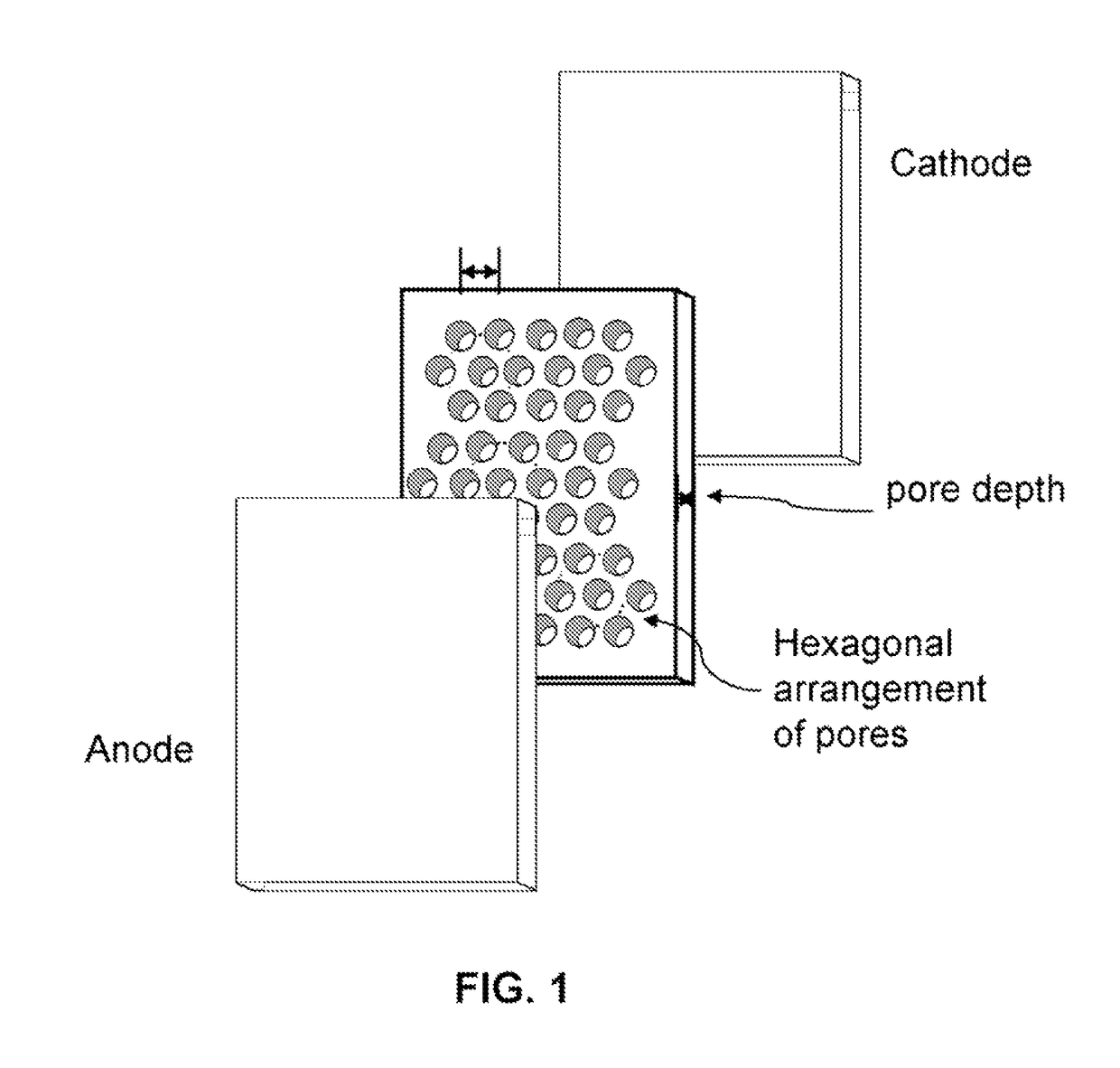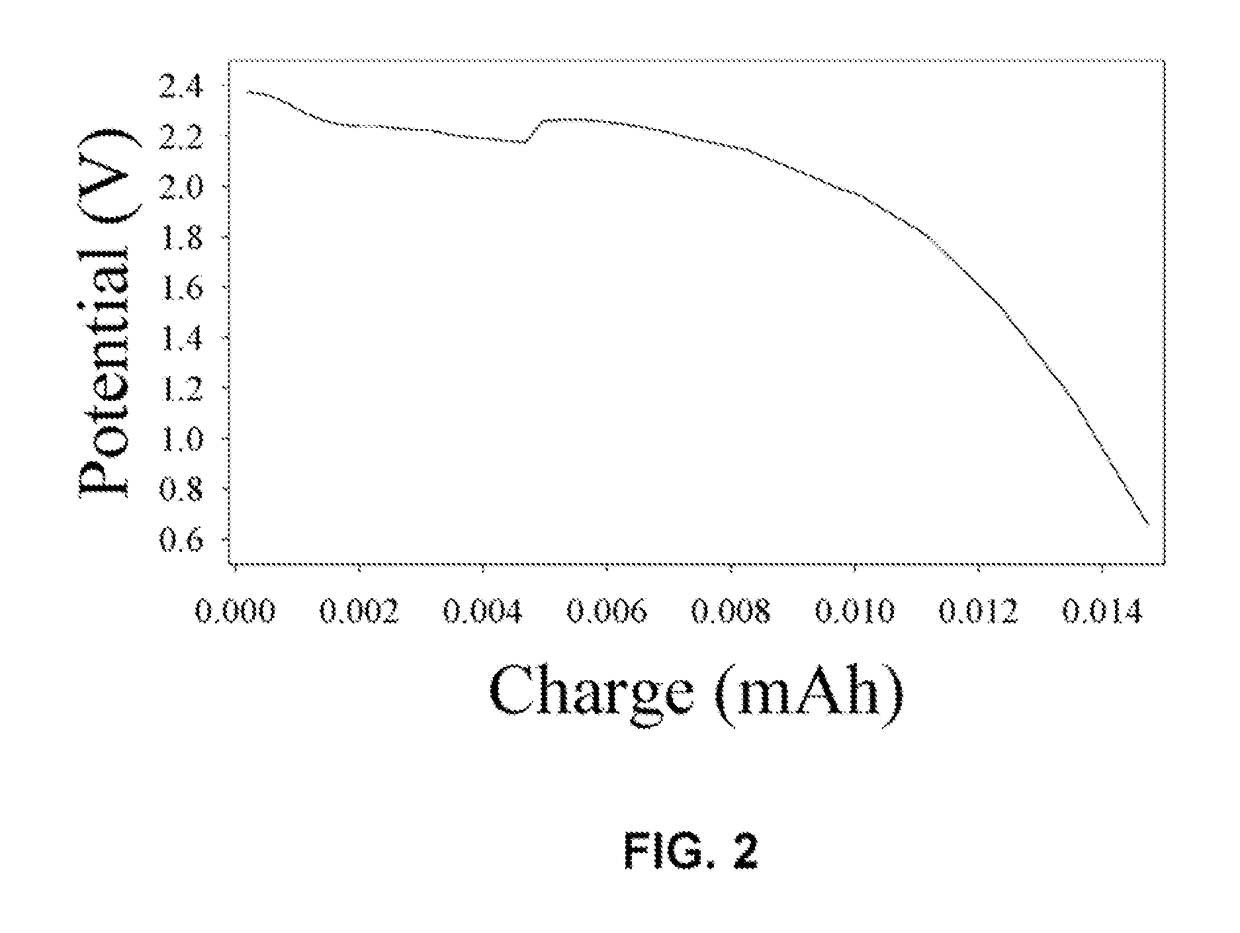Unique battery with an active membrane separator having uniform physico-chemically functionalized ion channels and a method making the same
a technology of ion channels and active membranes, applied in the field of unique batteries, can solve problems such as failure to teach or even suggest, and achieve the effect of reducing ion conductivity and maximizing ion conductivity
- Summary
- Abstract
- Description
- Claims
- Application Information
AI Technical Summary
Benefits of technology
Problems solved by technology
Method used
Image
Examples
example i
Membrane Example I
Anodized Aluminum Oxide Membrane
[0063]IA.—Aluminum strips of 98% purity (6.0 cm×1.5 cm×0.15 mm) were immersed in 0.3 molal oxalic acid maintained at 276 K and anodized at 40 VDC until transparent. Residual aluminum islands in the translucent anodized aluminum oxide (AAO) films were removed by oxidation using a solution of CuCl2 in dilute HCl. The films were washed with deionized water, dried at 383 K for 15 minutes in air, and cooled under dry nitrogen. Removal of water coating the pore walls was accomplished by heating the membranes to 330 K under vacuum for two hours, or heating the membranes to 700 K under dry nitrogen.
[0064]IB.—Square pieces of aluminum foil, of 99.999% purity (2.0 cm×2.0 cm×0.10 mm) were, coated on one side with nail polished (to protect the covered side from anodization) and dried and then immersed in 0.3 molal oxalic acid maintained at 276 K and anodized at 40 VDC until transparent. Residual aluminum islands in the translucent anodized alumi...
example ii
Membrane Example II
AAO-Coated (Salt) Membrane
[0067]IIA.—The pores in an AAO membrane were coated with organic salts, such as lithium triflate and lithium dodecyl sulfonate, by the application of solutions of these salts in THF, followed by solvent evaporation at elevated temperatures in a nitrogen atmosphere. The membranes were heated by laying them flat on a heating mantel. The application of the salt solutions was done drop wise on the top surface of the membrane.
[0068]IIB.—The pores in an AAO membrane were coated with inorganic salts, such as lithium iodide and lithium bromide, by the direct application of these salts to the membrane surface and heating the membrane under nitrogen gas in a furnace to 400-500K or to the melting point of the salt.
[0069]One membrane was dried at 773 K in air and then coated with molten LiBr at the same temperature.
[0070]IIC—The Fabrication of a AAO+Lil Solid-State Electrolyte-Separator
[0071]A circular area of 1.3 cm diameter was selectively anodized...
example iii
Membrane Example III
[0072]The pores of an AAO membrane were coated with a layer of a polymer electrolyte to form an ion conducting separator / electrolyte monolith. The polymer electrolyte was composed of PEO and lithium triflate and had an oxygen to lithium ion ratio of 8:1, and which was made by a well-know procedure. The pore walls were coated by placing the membrane on the surface of a hot plate and heating to 400 K in a dry nitrogen gas atmosphere. The polymer electrolyte was smeared onto the surface of the membrane and allowed to permeate the pores for a period of 10 minutes. The AAO membrane was turned over and the procedure was repeated. Any excess polymer on(e) top or bottom faces of the membrane was removed from the surface. Complete and uniform coating of the pores with polymer electrolyte required several minutes to several hours of heating; longer periods of heating were required for thicker membranes. A piece of lithium foil (anode) was contact...
PUM
| Property | Measurement | Unit |
|---|---|---|
| Thickness | aaaaa | aaaaa |
| Thickness | aaaaa | aaaaa |
| Thickness | aaaaa | aaaaa |
Abstract
Description
Claims
Application Information
 Login to View More
Login to View More - R&D
- Intellectual Property
- Life Sciences
- Materials
- Tech Scout
- Unparalleled Data Quality
- Higher Quality Content
- 60% Fewer Hallucinations
Browse by: Latest US Patents, China's latest patents, Technical Efficacy Thesaurus, Application Domain, Technology Topic, Popular Technical Reports.
© 2025 PatSnap. All rights reserved.Legal|Privacy policy|Modern Slavery Act Transparency Statement|Sitemap|About US| Contact US: help@patsnap.com



